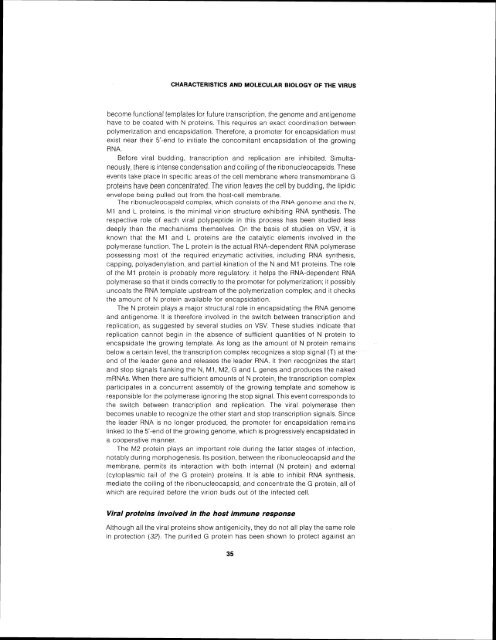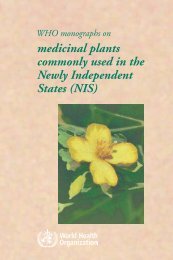in rabies - libdoc.who.int - World Health Organization
in rabies - libdoc.who.int - World Health Organization
in rabies - libdoc.who.int - World Health Organization
Create successful ePaper yourself
Turn your PDF publications into a flip-book with our unique Google optimized e-Paper software.
CHARACTERISTICS AND MOLECULAR BIOLOGY OF THE VIRUS<br />
become functional templates for future transcription, the genome and antigenome<br />
have to be coated with N prote<strong>in</strong>s. This requires an exact coord<strong>in</strong>ation between<br />
polymerization and encapsidation Therefore, a promoter for encapsidation must<br />
exist near their 5'-end to <strong>in</strong>itiate the concomitant encapsidation of the grow<strong>in</strong>g<br />
RNA.<br />
Before viral budd<strong>in</strong>g, transcription arid replication are <strong>in</strong>hibited. Simultaneously,<br />
there is <strong>in</strong>tense condensation and coil<strong>in</strong>g of the ribonucleocapsids. These<br />
events take place <strong>in</strong> speclfrc areas of the cell membrane where transmembrane G<br />
have been concentrated. The vir~on<br />
prote~ns<br />
leaves the cell by budd<strong>in</strong>g, the lipidic<br />
envelope be<strong>in</strong>g pulled out from the host-cell membrane.<br />
The ribonucleocapsid complex, which consists of the RNA genome and the N,<br />
M1 and L prote<strong>in</strong>s, is the ni<strong>in</strong><strong>in</strong>ial virion structure exhibit<strong>in</strong>g RNA synthesis. The<br />
respective role of each viral polypeptide <strong>in</strong> this process has been studied less<br />
deeply than the mechanisms themselves. On the bass of studies on VSV, it is<br />
known that the M1 and L prote<strong>in</strong>s are the catalytic elements <strong>in</strong>volved <strong>in</strong> the<br />
polyrnerase function. The L prote<strong>in</strong> is the actual RNA-dependent RNA polymerase<br />
possess<strong>in</strong>g most of the required enzymatic activities, <strong>in</strong>clud<strong>in</strong>g RNA synthesis,<br />
capp<strong>in</strong>g, polyadenylaton, and partial k<strong>in</strong>ation of the N and M1 prote<strong>in</strong>s. The role<br />
of the M1 prote<strong>in</strong> is probably more regulatory: it helps the RNA-dependent RNA<br />
polymerase so that it b<strong>in</strong>ds correctly to the promoter for polymerization; it possibly<br />
uncoats the RNA template upstream of the polymerization complex; and it checks<br />
the amount of N prote<strong>in</strong> available for encapsidation.<br />
The N prote<strong>in</strong> plays a major structural role <strong>in</strong> encapsidat<strong>in</strong>g the RNA genome<br />
and antigenome. It is therefore <strong>in</strong>volved <strong>in</strong> the switch between transcription and<br />
replication, as suggested by several studies on VSV. These studies <strong>in</strong>dicate that<br />
replication cannot beg<strong>in</strong> <strong>in</strong> the absence of sufficient quantities of N prote<strong>in</strong> to<br />
encapsidate the grow<strong>in</strong>g template. As long as the amount of N prote<strong>in</strong> rema<strong>in</strong>s<br />
below a certa<strong>in</strong> level, the transcription complex recognizes a stop signal (T) at the.<br />
end of the leader gene and releases the leader RNA. It then recognizes the start<br />
and stop signals flank<strong>in</strong>g the N, Ml, M2. G and L genes and produces the naked<br />
mRNAs When there are sufficient amounts of N prote<strong>in</strong>, the transcription complex<br />
participates <strong>in</strong> a concurrent assembly of the grow<strong>in</strong>g template and somehow is<br />
responsible for the polymerase ignor<strong>in</strong>g the stop signal. This event corresponds to<br />
the switch between transcription and replication The viral polymerase then<br />
becomes unable to recognize the other start and stop transcription signals. S<strong>in</strong>ce<br />
the leader RNA is no longer produced, the promoter for encapsidation rema<strong>in</strong>s<br />
l<strong>in</strong>ked to the 5'-end of the grow<strong>in</strong>g genome, which is progressively encapsidated <strong>in</strong><br />
a cooperative manner.<br />
The M2 prote<strong>in</strong> plays an important role dur<strong>in</strong>g the latter stages of <strong>in</strong>fection,<br />
notably dur~ng morphogenesis. Its position, between the ribonucleocapsid and the<br />
membrane, permits its <strong>in</strong>teraction with both <strong>in</strong>ternal (N prote<strong>in</strong>) and external<br />
(cytoplasmic tail of the G prote<strong>in</strong>) prote<strong>in</strong>s. It is able to <strong>in</strong>hibit RNA synthesis,<br />
mediate the coil<strong>in</strong>g of the ribonucleocapsid, and concentrate the G prote<strong>in</strong>, all of<br />
which are required before the virion buds out of the <strong>in</strong>fected cell.<br />
Viral prote<strong>in</strong>s <strong>in</strong>volved <strong>in</strong> the host immune response<br />
Although all the viral prote<strong>in</strong>s show antigenicty, they do not all play the same role<br />
<strong>in</strong> protection (32). The purified G prote<strong>in</strong> has been shown to protect aga<strong>in</strong>st an
















